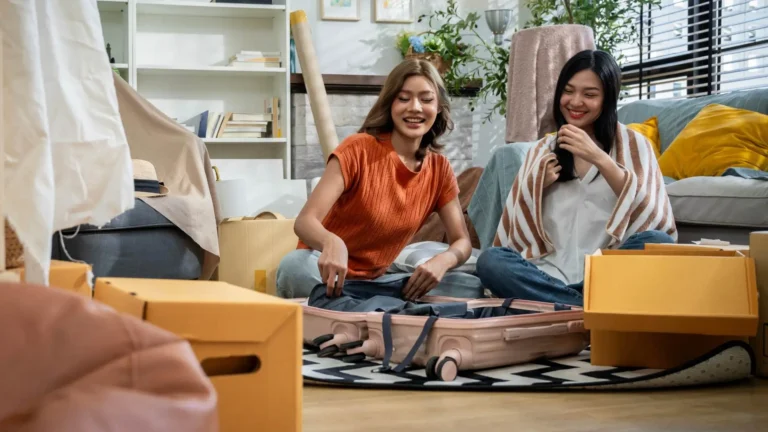Table of Contents
Most people see downsizing as a hardship and come up with the idea of it as a life with less in every way, that is, smaller rooms, a smaller number of possessions, and cutting down lifestyle in a sense. However, in fact, downsizing is not about making your life smaller but bringing it down to a size that is more to your liking according to your current needs. In fact, moving to a smaller home might set you free from the superfluous burden of maintenance, clutter, and bills that no longer belong to your lifestyle. You may turn this process from a downgrade to an upgrade in comfort, freedom, and peace of mind instead.
The change in feeling is also very important. The societal value attached to a bigger house and more possessions as the good quality of life for a long time was a sign of good living conditions. However, many older people realize that quietness, simplicity, and fun are the real indicators of comfort. It might sound paradoxical, but having less can indeed result in having more mental clarity.
Also, the house which is smaller in size and takes less time to clean and manage is like you having a ticket to a very important experience whether it is traveling, engaging in hobbies, having family time, or just relaxing without the stress of a long to-do list hanging over your head.
In this stage of life, comfort can be defined as being mobile, low stress, and financially secure, rather than just by the area of the house in square feet. If you begin to see downsizing as a step towards a more deliberate life, then you will be inviting deeper satisfaction.
Understanding the True Purpose of Downsizing
Every downsizing journey starts with understanding why you’re doing it. Some retirees want to reduce housing costs so their savings stretch further. Others want to move closer to family or into a community that supports an active lifestyle. Some are simply tired of maintaining large homes that feel empty once children have moved out. No matter the reason, the key is making sure your motivation aligns with your long-term goals.
Downsizing should support not only your financial situation but also your emotional and social well-being. If your goal is to enjoy a peaceful retirement, moving to a community with accessible healthcare, walkable areas, and social engagement opportunities may make more sense than staying in a big house filled with unused space. Similarly, if you’re planning to travel often, a smaller, low-maintenance home can give you the flexibility to do so without worrying about upkeep.
Financial planning plays a central role in this process. Retirement transitions come with unpredictable expenses, and preparing for them in advance helps protect your savings.
Tools like Beem’s Everdraft™ provide a layer of security during these transitions. Whether you encounter scheduling overlaps between selling and buying homes or need to cover deposits, moving fees, or short-term accommodations, having a safety net ensures the transition remains smooth and stress-free. Everdraft™ allows you to manage these temporary costs without dipping into long-term retirement funds, which helps you stay aligned with your goals.
Step 1 – Identify What Truly Adds Value to Your Life
The first step in downsizing is understanding what you genuinely want to keep. Instead of focusing on minimalism as a strict system, think of it as keeping items that bring joy, have functional value, or support your lifestyle. Everything else can be gifted to loved ones, donated to organizations, sold for extra cash, or digitized if possible.
This process is more emotional than practical for many people. Certain belongings carry memories, and letting go can feel like losing a part of your history. But filtering your possessions through the lens of “joyful essentials” helps you keep what truly matters while freeing up space—physically and emotionally. Reducing clutter can instantly make your home feel more comfortable by improving airflow, increasing light, and removing visual stress. The result is a living space that feels intentional and nurturing rather than crowded.
Step 2 – Choose a Home That Fits Your Next Chapter
Once you know what’s valuable to you, it becomes easier to choose the right home for your next chapter. A retirement-friendly home prioritizes easy movement, convenient access to daily needs, and affordability. Instead of thinking of it as moving into a smaller place, think of it as moving into a better-fitting place—one where everything you need is within reach, and nothing feels burdensome.
A smaller space may bring trade-offs, but many of them work in your favor. You might lose a spare bedroom but gain better amenities or a more vibrant community. You may sacrifice storage space but gain proximity to family, medical facilities, or parks. Utility bills, maintenance costs, and property taxes often drop as well, creating more financial breathing room that directly enhances comfort.
In many cases, retirees choose homes in gated communities, senior-living apartments, or homes built with accessibility features like single-floor layouts, wide doorways, and low-maintenance materials. These choices aren’t just about space—they’re about crafting a lifestyle that feels safe, convenient, and peaceful.
Step 3 – Redefine Comfort: Quality Over Quantity
Downsizing invites you to think differently about the objects you bring into your home. Instead of filling your new space with many items, you can invest in fewer but higher-quality pieces. A comfortable sofa, an ergonomic chair, efficient appliances, and well-designed lighting can dramatically elevate comfort without requiring a large house.
Thoughtful design plays a big role in making smaller homes feel just as cozy, if not more so. Multi-functional furniture, like foldable desks or beds with built-in storage, maximizes room without compromising style. Natural light, warm colors, and smart layouts help create an inviting atmosphere. With the right choices, your smaller space can feel more modern, organized, and comforting than a large home ever did.
Consider using Beem to spend, save, plan and protect your hard-earned money like an pro with effective financial insights and suggestions.
Step 4 – Plan the Financial Side of Downsizing Carefully
The financial aspect of downsizing requires careful planning. Selling your old home, covering moving costs, and buying or renting a new place can create temporary cash flow gaps. Repairs and upgrades to prepare your home for sale, real estate commissions, taxes, relocation expenses, and new furniture purchases all add up quickly.
Budgeting ahead is the safest way to protect your retirement funds from being drained by surprise expenses. Understanding the current real estate market, consulting financial planners, and estimating costs accurately help you make informed decisions.
This is where Beem’s Everdraft™ becomes particularly useful. Instead of dipping into investments or emergency savings to cover sudden moving or renovation costs, Everdraft™ acts as a zero-interest, flexible backup. It helps bridge financial timing gaps during transitions—whether you need to pay movers, handle security deposits, or temporarily cover overlapping housing expenses. The freedom to handle these costs without stress allows you to focus on settling into your new home comfortably.
Step 5 – Simplify Without Losing Your Lifestyle
Downsizing doesn’t mean giving up the activities and routines that make life enjoyable. Instead, it invites you to find creative ways to preserve them in a more efficient space. Many retirees discover that they can continue pursuing their passions by joining community clubs, hobby groups, travel communities, or fitness centers that offer shared spaces.
If you enjoyed hosting gatherings, you can still invite friends over by using flexible seating and layout options. If you love gardening, balcony planters or community gardens can keep the hobby alive. Social connections don’t depend on having a large home; they thrive through engagement, curiosity, and shared experiences.
The goal is to carry your lifestyle into your new environment—just with fewer physical burdens. Comfort comes from meaningful routines, not from storing items you rarely use.
Step 6 – Maximize Cash Flow After Downsizing
One of the biggest financial benefits of downsizing is the ability to free up cash. Selling a larger home or renting it out can generate significant funds that can be reinvested into safe, low-risk financial instruments or passive income opportunities. These additional income streams can supplement your retirement funds and increase long-term stability.
Beem’s budgeting tools help retirees maintain clarity over cash flow and spending patterns after downsizing. Combined with Everdraft™, which ensures liquidity during transitions, retirees can manage their finances with confidence and avoid unnecessary stress.
Step 7 – Stay Emotionally Comfortable During the Transition
Downsizing is not just a financial decision; it’s an emotional one. Leaving a home filled with memories can stir up feelings of loss or uncertainty. The best way to navigate this is to approach downsizing gradually. You can declutter in phases, involve family members in decisions, or give sentimental items to loved ones who will appreciate them.
Allowing yourself time to adjust helps you focus on the new opportunities ahead rather than what you’re parting with. A smaller home often brings new friendships, fresh routines, and a renewed sense of peace.
Step 8 – Build a “Comfort Cushion” for Unexpected Expenses
Every move comes with unexpected costs—temporary rentals, home repairs, storage fees, or new appliances. Building a financial cushion specifically for downsizing ensures you’re prepared. Liquidity is crucial during transitions, as it allows you to make decisions confidently.
Everdraft™ serves as a reliable backup during this process. It protects your savings from unplanned expenses by giving you a zero-interest fallback when you need it. This ensures that your comfort remains intact, even when surprises come your way.
The Secret: Smart Planning + Emotional Balance
The real secret to downsizing without losing comfort lies in embracing a balance between practicality and emotion. Financial readiness ensures stability, emotional acceptance provides peace, and thoughtful planning creates a home that supports your lifestyle. Downsizing is not about having less—it’s about making room for more meaningful living.
Conclusion – Living More Comfortably With Less
If downsizing is done intentionally it can be a way to be liberated, have less stress and live a simpler and better retirement. With Beem’s Everdraft™ helping through financial transitions, retirees can take the next step without doubt knowing they have a safety net that shields both their comfort and their savings. Downsizing is not a loss, it is an opportunity to design a life that is lighter, simpler, and more rewarding. Download the Beem app today!
FAQs on the Secret to Downsizing
How can I downsize without feeling like I’m giving up too much?
Stay focused on keeping items that have emotional or functional value. Comfort comes from meaningful belongings, not from quantity.
What’s the best age to start downsizing for retirement?
Beginning the process around three to five years before retiring allows ample time for planning and thoughtful decision-making.
How can I manage the costs of moving and resettling?
Plan ahead, budget carefully, sell unused items, and use tools like Beem’s Everdraft™ for temporary financial flexibility.
Does downsizing always save money?
In most cases yes, but savings vary depending on location, type of home, and lifestyle choices.
What are ways to keep comfort in a smaller home?
Invest in ergonomic furniture, maximize natural light, create multipurpose rooms, and stay socially active within your community.















































